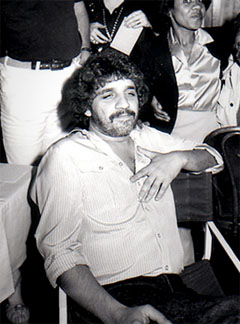|
| Magriel's NYT Columns |

Michael Maxakuli, director of the
Las Vegas Backgammon Club The Eldorado Backgammon Classic was held recently in Reno. The host for this event was the Las Vegas Backgammon Club. The tournament drew most of the top players from the West Coast. The Las Vegas Backgammon Club, under the direction Michael Maxakuli, has become the largest and most active regional backgammon organization in the country.
Results in the championship division: Paul Magriel defeated Dennis Stone in the finals; semifinalists were Charles Papazian and Bill Arkin. Bill Eisenberg overcame Tom Wheeler in the consolation.
Zim Alyosha triumphed over Patrick Maxfield in the intermediate section, and Del Simone won the beginner’s section.
Stone (Black) demonstrated his skillful technique in the diagrammed position taken from his semifinal match against Magriel (White). Black has doubled and has an overwhelming advantage. Two of White’s men have been hit and are on the bar.
In addition, White has two more men exposed on the 5- and 1-points. Thus, Black has good prospects of closing White out by completing his home board. White, with four men on the bar, would then almost certainly lose a gammon (double game) and possibly even a backgammon (triple game). Black, however, must be careful to avoid being hit during the bearoff — White, with a strong home board, could still win the game.
|
| Black to play 5-2. |
Furthermore, by making the 5-point, Black builds his points in sequence and so creates a prime. As a result, even if White manages to establish the 1-point, he will still be trapped. Nevertheless, as Stone recognized, making the 5-point would be a serious mistake.
|
|
|
For a safe bearoff, it is essential to make the 1-point in order to prevent White from doing so. If White is allowed to make the 1-point, then White will have what is called a “well-timed 1-point game.” The bearoff will then be surprisingly dangerous. In fact, trial and error have shown that even with the best play, Black will be forced to leave a shot almost 90 percent of the time.
With the correct play, White is prevented from making the 1-point but may be able to establish the 5-point. Black, however, has little to fear in this case. Black should have no trouble bearing his men past the 5-point and off safely. Indeed, as happened in the actual game, even if White rolls a 5 immediately, White is quite unlikely to avert a gammon.
Rollout
 Tom Keith 2013 |
|
Money play White owns 2-cube Black rolls 5-2 1296 games with VR Checker play: 2-ply Cube play: 3-ply Red |
| 5-2: | Game | G | BG | Equity | ||||
| 1 | 6/1*, 3/1 |
W L |
.9364 .0636 |
.8584 .0011 |
.0806 .0000 | +1.7832 |

| (a) |
| 2 | 10/5*, 7/5 |
W L |
.8677 .1323 |
.7624 .0028 |
.1607 .0002 | +1.5976 | (0.1856) | (b) |

|
|

